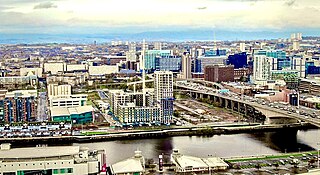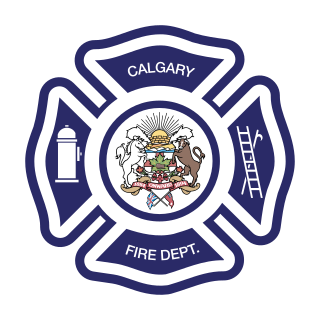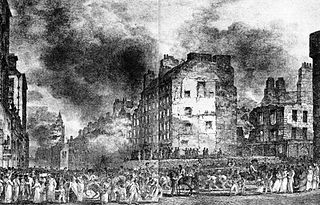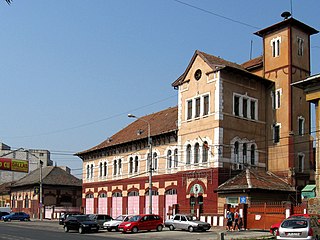
Anderston is an area of Glasgow, Scotland. It is on the north bank of the River Clyde and forms the south western edge of the city centre. Established as a village of handloom weavers in the early 18th century, Anderston was an independent burgh of barony from 1824 until it was incorporated into the City of Glasgow in 1846.

The London Fire Brigade (LFB) is the fire and rescue service for London, the capital of the United Kingdom. It was formed by the Metropolitan Fire Brigade Act 1865, under the leadership of superintendent Eyre Massey Shaw. It has 5,992 staff, including 5,096 operational firefighters and officers based at 102 fire stations.

The London Salvage Corps was maintained by the fire offices of London. The corps was first formed in 1865 and began operations in March 1866. It was inspired by the Liverpool Salvage Corps which had been formed in 1842, to reduce the loss and damage caused by fires, to help mitigate the effects of fire and of fire-fighting and to salvage both premises and goods affected by fire.

The San Francisco Fire Department (SFFD) provides firefighting, hazardous materials response services, technical rescue services and emergency medical response services to the City and County of San Francisco, California.

The Calgary Fire Department (CFD) provides fire services for the city of Calgary, Alberta.
The Worsley Hotel Fire was a major arson fire at the Worsley Hotel in Maida Vale, London on 13 December 1974. It killed seven people, including a probationary firefighter.
Salvage Corps came into existence in the 19th century. With the growth of cities, fires and insurance, underwriters in several cities established fire fighting services to reduce losses. As municipal fire brigades became more competent in the 20th century, the private fire companies cut back their services and emphasised salvaging property after the regular firemen had done their job.
The Gillingham Fair fire disaster occurred on 11 July 1929 in Gillingham, Kent, England, when a firefighting demonstration went wrong, and resulted in the deaths of 15 men and boys.

The Honour medal for firefighters is a state decoration of France bestowed by the Ministry of the Interior to members of the French Fire Service.
The Kilbirnie Street fire, on Friday 25 August 1972, was a warehouse fire in the Port Eglinton area, on the south side of Glasgow, Scotland, which killed seven Glasgow Fire Service firemen in a flashover while they were trying to rescue a trapped colleague. What started as a routine industrial premises fire resulted in one of the highest losses of life for the UK Fire Service at a single incident in peacetime.
The James Watt Street fire on Monday, 18 November 1968, was a fatal factory fire in Glasgow, Scotland leading to a large loss of life, with 22 employees killed. The number of fatalities was a consequence of the building retaining barred windows, a feature remaining from its previous use as a whisky bond. Around 100 firemen from Glasgow Fire Service attended this incident, which reinforced Glasgow's reputation for tragic fires in the 30 years after the Second World War.

The Great New York City Fire of 1845 broke out on July 19, 1845, in Lower Manhattan, New York City. The fire started in a whale oil and candle manufacturing establishment and quickly spread to other wooden structures. It reached a warehouse on Broad Street where combustible saltpeter was stored and caused a massive explosion that spread the fire even farther.
The Hellenic Fire Service is the national fire and rescue service of Greece. It is part of the Ministry for Citizen Protection.

The Great Fire of Edinburgh was one of the most destructive fires in the history of Edinburgh. It started on Monday, 15 November 1824, and lasted for five days, with two major phases.
The Vulcan Society, founded in 1940, is a fraternal organization of black firefighters in New York City.
Glasgow Fire Service provided emergency services such as fire prevention, firefighting, emergency medical services and technical rescue to Glasgow, the largest city in Scotland and the third-largest city in the United Kingdom. On 16 May 1975, the Glasgow Fire Service was absorbed into the now defunct Strathclyde Fire and Rescue Service.

The Croydon Fire Brigade was the fire and rescue service for the County Borough of Croydon. Established in 1867, it was absorbed into the London Fire Brigade in 1965.

The Iosefin Fire Station is a historical monument in Timișoara, Romania, designed by Hungarian architect László Székely in the so-called "1900s style". It was built in the Iosefin district, near the old fire station, on the site of the old watchtower. It is currently the headquarters of Timișoara Fire Department 2.

Glasgow Salvage Corps was a service in Glasgow, Scotland. It was founded after local fire insurance companies were concerned over losses in serious fires. They inspected buildings for fire safety, increasing premiums if any of their recommendations were not met, and attended fires alongside the Fire Brigade. It was founded in November 1873 and operated until 1 April 1984, when its functions were transferred to the Glasgow Fire Service. Similar salvage corps also operated in London and Liverpool.











